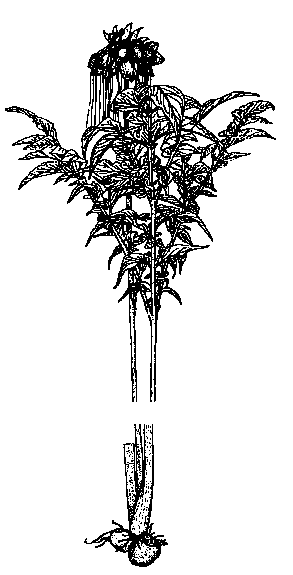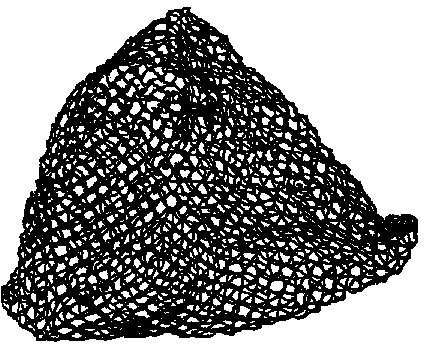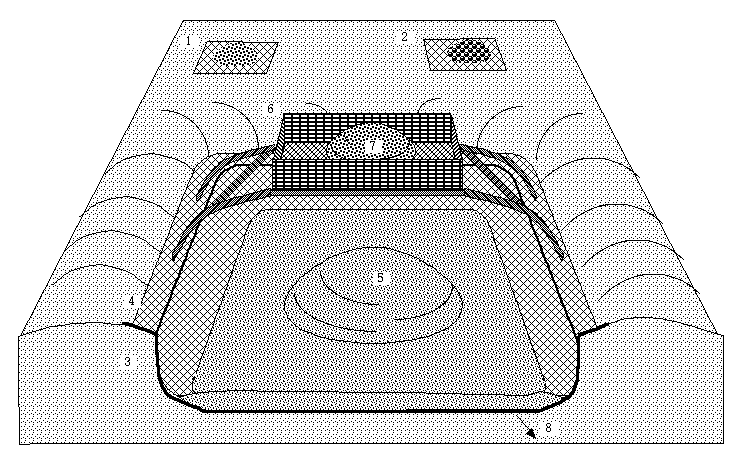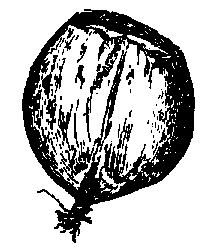

|
Essays on the Marshallese Past
Arrowroot-Makm–k Famine food, clothes starch
|
A number of food plants were traditionally utilised by the Marshallese. The
main food plant was, and still is, without doubt,
The plant is decidious, sprouts in early (northern) spring, flowers in the summer months and matures October to January, at which time the tubers have grown to full size. The tubers are commonly shaped like somewhat irregular flattish spheres, 0.5-4" in diametre with a thin, brown skin and whitish starchy interior.

An
Arrowroot is common on the ground layer in coconut grassland/srcubland, if the cover
with other plants is not too dense. The plant is said to have very good resistance to droughts. The
stems and leaves above the ground may wither entirely, but the tuber soon sends up new stalks
and leaves.
Nutritional Value
Arrowroot starch is the richest unenriched natural starch on earth. The starch content of the
tubers varies from 10-25% of the tuber weight depending on growth location and soil substrate.
Unprocessed tubers in the Marshall Islands contain approximately 80% water, 10% fibre and
~10% extractable starch. The fine crystal structure of arrowroot starch makes it easily digestable
and therefore a favourite food for weak and sick people as well as small children.
Arrowroot production
Starting at plant cycle, the crop of the previous year is harvested. Only the large tubers are taken. The small tubers are left behind, acting as seedlings for next year's crop.
The collected arrowroot tubers are placed in a larger mesh bag
(
A pit is dug 1-2m diameter and 0.5-0.75m deep. Sides and bottom of the pit are lined with coconut fronds and a large, strongly plaited mat which protrudes a good distance over the edge of the pit. This pit serves as a trough in which to catch the strained out flour.
Resting on the orifice of the pit is a wooden box, which acts as a strainer, and whose lower part is open and only covered with a mesh made from coconut coir. In order to prevent any large pieces as well as any foreign material from falling into the mat, the coconut mesh is covered with a sticky flexible creeping root.

Large-meshed netbag to wash arrowroot in the lagoon.
The red mass is wrapped in the net-like wrapper of young coconut leaves, which acts as a real filtering cloth. This is placed in the box and watered with sea-water and continuously kneaded.

A late 19th century, sometimes hand-held
The water carrying with it arrowroot starch runs into the trough-like mat underneath, the starch gradually settling to the bottom. After two or even three hours the sifted starch is sifted for a second or even a third time, the last washing with fresh water. During this pounding and leaching process, the arrowroot loses its bitterness. When all the water is skimmed off or has dissipated, the flour is scraped together and hung up in the wrapping of a young coconut leaf, thus allowing the water to run off and drip out of the starch.

Schematic view of the arrowroot sifting process. 1-Mat with ground
arrowroot tubers; 2-Mat with cleaned arrowroot tubers; 3-Pit excavted into the sand; 4-Coarse
mat used as lining of the pit place above a layer of coconut leaves (not shown); 5-Heap of sifted
arrowroot starch in the pit; 6-
After about two or three days the hardened lump of starch is crushed on a mat and placed in the sun so to dry out thoroughly. Provided it is kept dry and away from weevils, ants, cockroaches and the like, the starch will keep indefinitely.
About seven baskets of unprocessed tubers result in one basket of processed dried flour.

A coconut shell serving as a trade container for arrowroot starch from
Today, throughout the Marshall Islands there exists a notion that arrowroot no longer
grows as large as it used to. Arrowroot, it is claimed, also no longer grows in some areas as tall.
Both is brought into connection with the effects of the nuclear testing which took place on
Based on archival and field research the following was found:
Previous botanical and agricultural studies had shown that arrowroot does very well under coconut, provided that competing vegetation is kept away. This arrowroot would be a very suitable intercrop in copra plantations.
Based on an analysis of arrowroot tending, production and starch extraction, the following economic calculation has been drawn up, based on a household comprising two able-bodied males (15-64 years of age), and two male minors. Female labour input, which would speed up the process, was not taken into account as this is not traditional "custom".
Based on the
This cost of $0.84 or less per pound needs to be compared with the costs of starch in
Import substitution is feasible, and wide variety of traditional dishes were once made with
arrowroot flour.
![]()
| select from the following... | ||||||
| |
||||||
|
Digital Micronesia-An
Electronic
Library & Archive
is provided free of charge
as an advertising-free
information service
for the world community. It is being maintained by Dirk
HR Spennemann, Associate
Professor in Cultural
Heritage Management, Institute of Land, Water and Society and School
of Environmental & Information Sciences, Charles
Sturt University,
Albury, Australia. The server
space and technical support are provided by Charles
Sturt University as part of its commitment
to regional engagement. Environmental
SciencesInformation
Sciences
|
||||||